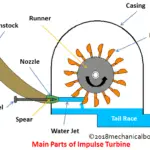In industries where fluids need to be controlled, valves are used to regulate, direct or control the fluid flow by opening or closing a fluid passage using a gate, ball, or restrictive disc. Depending on the use cases, the valves could be manually, pneumatically, or electrically operated. These valves come in different sizes and shapes, each designed for unique applications.
Below, we’ve rounded up the six different common valves used in various industrial settings. Read on to get started.
1. Solenoid Valve
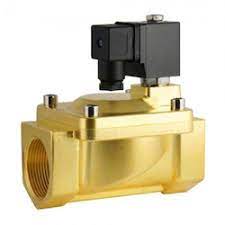
Solenoid valves are electrically controlled devices used to open, close, mix, or distribute fluid media. These valves are fast-acting and feature an electric coil called a solenoid with a moveable ferromagnetic core in its center. The ferromagnetic core closes the orifice when the solenoid valve is in the rest position, restricting fluid flow. Once an electric current passes through the coil, a magnetic field is created, which exerts an upward force on the ferromagnetic core, opening the small orifice.
Solenoid valves are used to control clean liquid and gases and are common in irrigation systems, heating systems, car washes, vacuum, and compressed air systems. These valves are categorized based on their valve function and operation type. Under valve function, we have the normally open (NO), normally closed (NC), and bi-stable valves. And for the operation type, we have direct, indirect, and semi-direct valves.
2. Gate Valve
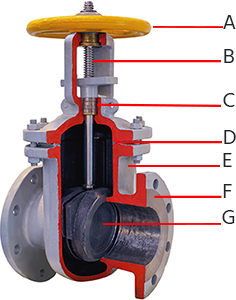
Another popular type of valve is the gate valve used to control the fluid flow by either opening/lifting the gate or closing/lowering the gate. Gate valves can be manually operated or automated, but manual types are more cost-effective due to the infrequent valve operation. These valves feature an unobstructed passageway; hence there’s minimal pressure loss inside the valve. Gate valves are slow-acting and are best used to fully close or open flow.
Depending on the applications, these valves come in a variety of designs. The two distinguishing factors are gate design and the type of bonnet used.
Gate valves can have bolted, screw-in, or pressure seal bonnets. Similarly, there is a wide variety of gate designs, such as wedge gates, parallel slide gates, parallel expanding, and knife gates.
3. Ball Valve
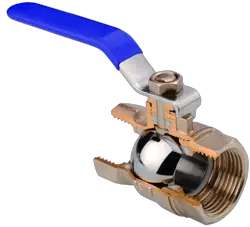
Unlike the gate valve, ball valves are used to control fluid flow using a rotary ball with an orifice instead of a gate. Ball valves are commonly used as shut-off valves, thanks to the more reliable sealing and longer service life. These valves are a bit costly than gate valves but are more resistant to contaminated media than the other valve types.
Even so, ball valves are rarely used as control valves due to the limited accuracy compared to other valves. Popular ball valve types include threaded, hydraulic, flanged, and vented ball valves.
4. Butterfly Valve
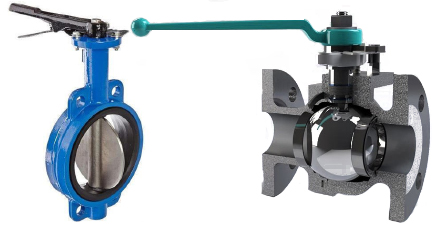
Butterfly valves belong to a group of quarter-turn valves that work just like ball valves, except that they are cheaper, lightweight, and quicker. These valves have a smaller installation footprint and can be operated by gears, handles, or automatic actuators.
Butterfly valves are available in different types, each designed for specific applications and pressure ranges. They are often categorized based on their connection design (lug-style and wafer style), actuation method (manual and automatic), and closure design (concentric and eccentric). Common applications of butterfly valves include wastewater treatments, chemical & pharmaceutical, water supply, fuel handling, fire protection, etc.
5. Check Valves
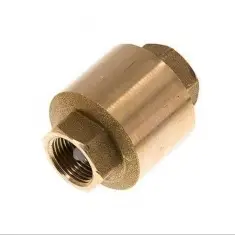
Check valves are fluid control devices used to limit the flow of liquid and gases to only one direction. These valves are also known as non-return valves or one-way valves, and they help prevent backflows in the system.
Check valves rely on pressure differential to allow or restrict fluid flow. When the pressure is high on the inlet side than the outlet, the valve opens and allows fluid to flow. However, when the pressure is high on the outlet side, the valve closes. Common types of check valves include spring-loaded in-line, spring-loaded Y, Ball, swing, and diaphragm valves.
6. Safety Valves
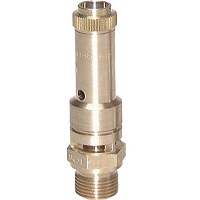
Safety valves are used to protect systems against overpressure, which could lead to fire hazards, malfunctions, or explosions. These valves are designed to work under all circumstances. For instance, when a system malfunctions or when pneumatic or electronic safety devices fail. And to achieve this, safety valves are fully controlled or operated by the systems media, meaning they only feature mechanical parts. They are specified by their opening pressure, so when the system reaches that pressure they open and release the excess pressure.
Safety valves are categorized into three main types: those with balanced bellows, valves with spring-loaded mechanisms, and piloted-operated valves. Each of these comes with its unique operation mode, but they all serve the same purpose.
Choosing the Right Valve for Your Application
All the above valves find their applications in different industries and settings, so the right choice will often depend on your unique use cases and preferences. That said, there are several other factors to consider when choosing a specific valve. For instance, the selection criteria for solenoid valves will vary from the selection criteria of check valves or safety valves. Be sure to seek professional help to avoid wrong decisions and potentially costly mistakes during the selection process.







